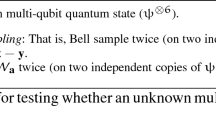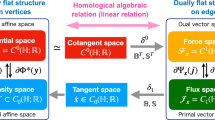Abstract
Monoid actions of trace monoids over finite sets are powerful models of concurrent systems—for instance they encompass the class of 1-safe Petri nets. We characterise Markov measures attached to concurrent systems by finitely many parameters with suitable normalisation conditions. These conditions involve polynomials related to the combinatorics of the monoid and of the monoid action. These parameters generalise to concurrent systems the coefficients of the transition matrix of a Markov chain. A natural problem is the existence of the uniform measure for every concurrent system. We prove this existence under an irreducibility condition. The uniform measure of a concurrent system is characterised by a real number, the characteristic root of the action, and a function of pairs of states, the Parry cocyle. A new combinatorial inversion formula allows to identify a polynomial of which the characteristic root is the smallest positive root. Examples based on simple combinatorial tilings are studied.






Similar content being viewed by others
Notes
A note on terminology: we avoid the use of the word deterministic since it has different meanings according to the scientific community that uses it. In Probability theory, deterministic is opposed to probabilistic. On the contrary, in Computer science, deterministic is opposed to non-deterministic, regardless of the existence of a probabilistic context; and non-deterministic refers to the existence of a choice in the evolution of the system for a given action. In the Computer science language, all the systems considered in this paper are deterministic.
References
Abbes S (2008) On countable completions of quotient ordered semigroups. Semigroup Forum 3(77):482–499
Abbes S (2017) Toward uniform random generation in 1-safe Petri nets. In: Fédou J-M, Ferrari L (eds) Random Generation of Combinatorial Structures – GASCom2016, volume 59 of Electronic Notes in Discrete Mathematics, pp 3–17
Abbes S, Keimel K (2006) Projective topology on bifinite domains and applications. Theoret Comput Sci 365(3):171–183
Abbes S, Mairesse J (2015a) Uniform and Bernoulli measures on the boundary of trace monoids. J. Combin. Theory Ser. A 135:201–236
Abbes S, Mairesse J (2015b) Uniform generation in trace monoids. In: Italiano G, Pighizzini G, Sannella D (eds) Mathematical foundations of computer science 2015 (MFCS 2015), part 1, vol 9234, LNCS, pp 63–75
Abbes S, Gouëzel S, Jugé V, Mairesse J (2017) Uniform measures on braid monoids and dual braid monoids. J Algebra 473(1):627–666
Baccelli F, Cohen G, Olsder G, Quadrat J-P (1992) Synchronization and linearity. Wiley, New York
Billingsley P (1995) Probability and measure, 3rd edn. Wiley, New York
Bousquet-Mélou M, Viennot X (1992) Empilements de segments et q-énumération de polyominos convexes dirigés. J Combin Theory Ser A 60:196–224
Cartier P, Foata D (1969) Problèmes combinatoires de commutation et réarrangements, volume 85 of Lecture Notes in Math. Springer, Berlin
Csikvári P (2013) Note on the smallest root of the independence polynomial. Combin Probab Comput 22(1):1–8
Desel J, Esparza J (1995) Free Choice Petri Nets. Cambridge University Press, Cambridge
Diekert V (1990) Combinatorics on traces, volume 454 of Lecture Notes in Computer Science. Springer, Berlin
Diekert V, Rozenberg G (eds) (1995) The book of traces. World Scientific
Gierz G, Hofmann KH, Keimel K, Lawson J, Mislove MW, Scott DS (2003) Continuous Lattices and Domains, volume 93 of Encyclopedia of Mathematics and its Applications. Cambridge University Press, Cambridge
Goldwurm M, Santini M (2000) Clique polynomials have a unique root of smallest modulus. Inform Process Lett 75(3):127–132
Keimel K, Lawson J (2009) D-completions and the d-topology. Ann Pure Appl Log 159:292–306
Kitchens BP (1997) Symbolic dynamics. One-sided, two-sided and countable state Markov shifts. Springer, Berlin
Krattenthaler C (2006) The theory of heaps and the Cartier-Foata monoid. Appendix to the electronic edition of Problèmes de commutations et réarrangements
Krob D, Mairesse J, Michos I (2003) Computing the average parallelism in trace monoids. Discret Math 273:131–162
Levit VE, Mandrescu E (2005) The independence polynomial of a graph – a survey. In: Proceedings of First Int Conf Algebr Inform Aristitle Univ Thessaloniki, pp 233–254
Lind D, Marcus B (1995) An introduction to symbolic dynamics and coding. Cambridge University Press, Cambridge
Murata T (1989) Petri nets: properties, analysis and applications. Proc IEEE 77 (4):541–580
Parry W (1964) Intrinsic Markov chains. Trans Amer Math Soc 112(1):55–66
Reisig W (1985) Petris nets: an introduction. EATCS monographs. Springer, Berlin
Romik D (2012) Arctic circles, domino tilings and square Young tableaux. Ann Probab 40(2):611–647
Rota G-C (1964) On the foundations of combinatorial theory I. Theory of Möbius functions. Z Wahrscheinlichkeitstheorie 2:340–368
Saldanha NC, Tomei C (1995) An overview of domino and lozenge tilings. Resenhas 2(2):239–252
Schützenberger M-P (1961) On the definition of a family of automata. Inform Control 4(2–3):245–270
Seneta E (1981) Non-negative matrices and Markov chains. Springer, Berlin
Stanley RP (1997) Enumerative combinatorics, vol 1. Cambridge University Press, Cambridge
Vershik A, Nechaev S, Bikbov R (2000) Statistical properties of locally free groups with applications to braid groups and growth of random heaps. Commun Math Phys 212(2):469–501
Viennot X (1986) Heaps of pieces, I : basic definitions and combinatorial lemmas. In: Combinatoire énumérative, volume 1234 of Lecture Notes in Mathematics. Springer, pp 321–350
Author information
Authors and Affiliations
Corresponding author
Additional information
Publisher’s note
Springer Nature remains neutral with regard to jurisdictional claims in published maps and institutional affiliations.
Rights and permissions
About this article
Cite this article
Abbes, S. Markovian dynamics of concurrent systems. Discrete Event Dyn Syst 29, 527–566 (2019). https://doi.org/10.1007/s10626-019-00291-z
Received:
Accepted:
Published:
Issue Date:
DOI: https://doi.org/10.1007/s10626-019-00291-z




